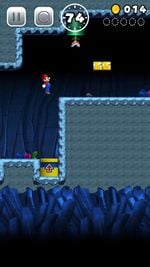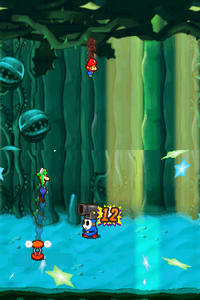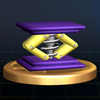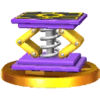Trampoline
- "Spring" redirects here. For information about the springs found in Boo's Boneyard Galaxy from the game Super Mario Galaxy, see Spring (Super Mario Galaxy).
- “I found a springboard for you! Ground-pound it to bounce high!”
- —Luma, Super Mario Galaxy 2
Springboards[1][2], Spring Blocks[3], Springs or Trampolines[4], are items that appear in the Donkey Kong series and the Mario franchise.
History
Donkey Kong series
Donkey Kong
In the Donkey Kong arcade game, Donkey Kong would throw springs-like objects called jacks at Mario in the level 75m. If Mario gets hit by a jack, he loses a life. In Donkey Kong for the Game Boy, actual springboards appear alongside the harmful jacks. The Stationary Springs are found throughout levels. If Mario jumps on one, he can jump higher than usual.
Springboards can also be placed in the Game Boy game. When Mario jumps at a Spring block, the game freezes and the player has to place the Spring to any free point in the level. The Spring is timed, and disappears after the time has passed. This timer indicated with a music that starts playing as soon as the road is placed and gets faster gradually. The timer can be reset to 0 if Mario places another Spring within the first Spring's time limit, or any other placeable objects such as Roads, Ladders, and blocks. After disappearing, the Spring can then be placed with the Spring block again.
Donkey Kong Jr.
An actual springboard first appears in the sequel to Donkey Kong, Donkey Kong Jr., prominently featured in the game's second level. Junior can use it to jump over a gap but can also use it as a shortcut to reach the hovering platform above it.
Super Mario series
Super Mario Bros. / Super Mario Bros.: The Lost Levels
The Springboards' first appearance in the Mario franchise is in Super Mario Bros. They are used to jump to higher places in the game. With the right timing of pressing the button, the player will have Mario (or Luigi) be able to go high in the air.
In Super Mario Bros.: The Lost Levels, there is a green type of springboard that allowed Mario to stay in the air for a while.
Super Mario World
Springboards appear in Super Mario World, where they are known as Jumping Boards[citation needed]. This game marks the first time the player is able to carry a Springboard, an ability which would later be carried on to future games, including the New Super Mario Bros. series.
Super Mario Sunshine
In Super Mario Sunshine, Trampolines appear in Noki Bay. When water touches them, they shrink and Mario is able to carry them around, allowing him to reach different high places.
Super Mario Galaxy games
In Super Mario Galaxy and Super Mario Galaxy 2, there are two types of Springboards: blue Springboards can be used by simply jumping on them, and orange Springboards can bounce Mario extra high if he Ground Pounds on them.
Super Mario 3D World
Super Mario 3D World features enemy springboards known as Hop-Chops. Hop-Chops often appear in groups where the player must find which is the 'correct' Hop-Chop that, rather than simply falling apart, will turn into a functional springboard upon defeat. When turned into a springboard, they function almost identically to their appearances in other Mario games: They can be carried with the run button, thrown, jumped on, and hitting them with a ground pound will cause Mario or his friends to jump extra high. Springboards will turn back into Hop-Chops after a short period of time if they are not attacked again.
Super Mario Maker
Springboards return in Super Mario Maker and Super Mario Maker for Nintendo 3DS as items placed throughout the course. They are referred to as Trampolines. Mario and various objects can bounce on them. The springboard also appears in this game as a costume.
Super Mario Run
Super Mario Run uses a new variation of springboard. This object is triggered when a player taps while their character runs across its surface. It launches the player upwards and, if held, the character will slowly spin downwards at a 45 degree angle. In some levels, its priority is to take players to areas too high to be reached via jumps, while in others, players must take advantage of the slow descent to collect coins.
Club Nintendo

A Trampoline plays an important role in the Club Nintendo comic "Mario will hoch hinaus." Trying to impress Princess Peach, Mario uses one which pushes him extremely high. Even several hours later he is still not coming down.
Paper Mario
In Paper Mario, two types of Springboards appear: the red ones launch Mario straight up towards a set location, while the blue ones retain the player's control over Mario's jump.
Mario vs. Donkey Kong series
In the Mario vs. Donkey Kong series, springs are common objects, and appear to have a simpler design than in previous games. In Mario vs. Donkey Kong, they are needed to clear many levels, including some boss battles. They are placed on the ground and, sometimes, even in mid-air. However, springs themselves do not have enough force to launch Mario in the air, and so the player has to press the jump button while Mario is on a spring to make it effective, bouncing him higher than a normal jump.
Springs continue to appear in subsequent Mario vs. Donkey Kong games, where they are needed to guide the Mini Marios throughout many stages. They can be picked up and stored, then placed in special slots throughout a stage, much like other resource items, like Girders or Pink Blocks. In these games, the springs are either purple and bounce the Minis straight into the air, or yellow and bounce them on a wider arc. In this respect, they are named Vertical Springs (or High Springs[5]) and Horizontal Springs (or Long Springs[6]). In Mario vs. Donkey Kong 2: March of the Minis, there is a spiked springboard found in the Basement which bounces around the room and minis will break upon contact with it.
Mario & Luigi: Partners in Time
In Mario & Luigi: Partners in Time, Springboards (called Trampolines in-game) are very powerful Bros. Items that require the availability of all four Bros. Each Bro. jumps onto the Trampoline, then bounces high up, farther than even the top screen. Then, the Bros. come down in random order and stomp on the foe, and if timed correctly, jump back onto the Trampoline for a second (third, fourth etc.) jump. If the timing is missed, he will knock the Trampoline away, ending the assault after the other three have fallen. It functions similar to the Cannonballer, except the attacks can be landed indefinitely.
Super Smash Bros. series
In Super Smash Bros. Brawl and Super Smash Bros. for Nintendo 3DS / Wii U, the Spring from the original Donkey Kong appears in the game as a regular item. If jumped on, a player will be launched in the air much higher than with a normal jump. If the Spring is knocked on its side, however, the player will be launched sideways. A different kind of springboard also appears as a stage element throughout the Super Smash Bros. series, including the Subspace Emissary and Smash Run.
Trophy information
Super Smash Bros. Brawl
Super Smash Bros. for Nintendo 3DS / Wii U
Gallery
- SMB Tram.png
Super Mario Bros.
- Shine trampoline.png
Super Mario Sunshine
- PiT Trampoline sprite.PNG
Mario & Luigi: Partners in Time
Names in other languages
| Language | Name | Meaning |
|---|---|---|
| Japanese | ジャンプ台[7] Janpudai |
Jump Stand |
| Italian | Trampolino |
Trampoline |
| Korean | 스프링 Seupeuring |
Spring |
| Portuguese | Plataforma de Salto |
Jump Platform |
| Spanish | Trampolín |
Trampoline |
Trivia
- In Super Smash Bros. Brawl, if a player bounces on a spring, the sound effect from Donkey Kong Jr. from the spring that appears on the second level, can be heard.
- Some springboards in Super Mario Bros.: The Lost Levels make the player jump so high the character (Mario or Luigi) is off-screen for a few seconds until they come back falling from the top.
- The "springs" that Donkey Kong throws are actually jacks, as shown in Super Smash Bros. Brawl.
References
- ^ Hodgson, David S J, Bryan Stratton, and Stephen Stratton. Super Mario Sunshine Prima Official Strategy Guide. Page 15.
- ^ Super Mario 3D World Prima Official Game Guide page 19.
- ^ Super Mario Bros. Nintendo 3DS Virtual Console digital instruction manual, page 10 / 13
- ^ Super Mario Maker spoken object name
- ^ Template:Ref quote
- ^ Mario vs. Donkey Kong: Tipping Stars digital manual Section 11
- ^ Shogakukan. 2015. Sūpā Mario Burazāzu Hyakka: Nintendō Kōshiki Gaido Bukku, New Super Mario Bros. section
- Tools/Equipment
- Artifacts
- Donkey Kong (game) Objects
- Donkey Kong (Game Boy) Items
- Mario & Luigi: Partners in Time Items
- Mario vs. Donkey Kong
- Mario vs. Donkey Kong 2: March of the Minis
- Mario vs. Donkey Kong: Minis March Again!
- Mario vs. Donkey Kong: Mini-Land Mayhem!
- Mario vs. Donkey Kong: Tipping Stars
- New Super Luigi U Objects
- New Super Mario Bros. Objects
- New Super Mario Bros. 2 Objects
- New Super Mario Bros. U Objects
- New Super Mario Bros. Wii Objects
- Super Mario 3D World Objects
- Super Mario Advance 4: Super Mario Bros. 3 Objects
- Super Mario Bros. Objects
- Super Mario Bros.: The Lost Levels Objects
- Super Mario Galaxy Objects
- Super Mario Galaxy 2 Objects
- Super Mario Maker Costumes
- Super Mario Maker Objects
- Super Mario Run Objects
- Super Mario Sunshine Objects
- Super Mario World Objects
- Super Smash Bros. Brawl
- Super Smash Bros. Brawl Items
- Super Smash Bros. Brawl Trophies
- Super Smash Bros. for Nintendo 3DS / Wii U
- Super Smash Bros. for Nintendo 3DS / Wii U Items
- Super Smash Bros. for Nintendo 3DS Trophies
- Super Smash Bros. for Wii U Trophies
- Super Smash Bros. Series Objects










